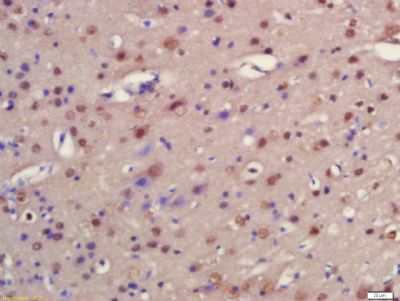FNIP1 Polyclonal Antibody
Purified Rabbit Polyclonal Antibody (Pab)
- 产品详情
- 实验流程
Application
| IHC-P, IHC-F, IF, ICC, E |
|---|---|
| Primary Accession | Q8TF40 |
| Reactivity | Rat, Dog, Bovine |
| Host | Rabbit |
| Clonality | Polyclonal |
| Calculated MW | 130555 Da |
| Physical State | Liquid |
| Immunogen | KLH conjugated synthetic peptide derived from human FNIP1 |
| Epitope Specificity | 101-200/1166 |
| Isotype | IgG |
| Purity | affinity purified by Protein A |
| Buffer | 0.01M TBS (pH7.4) with 1% BSA, 0.02% Proclin300 and 50% Glycerol. |
| SUBCELLULAR LOCATION | Cytoplasm. |
| SIMILARITY | Belongs to the FNIP family. |
| SUBUNIT | Forms homomultimers and heteromultimers with FNIP2. Interacts with FLCN (via C-terminus), with HSPCA and with the PRKAA1, PRKAB1 and PRKAG1 subunits of 5'-AMP-activated protein kinase (AMPK). Phosphorylated FLCN and AMPK are preferentially bound. |
| Post-translational modifications | Phosphorylated by AMPK. |
| Important Note | This product as supplied is intended for research use only, not for use in human, therapeutic or diagnostic applications. |
| Background Descriptions | May be involved in energy and/or nutrient sensing through the AMPK and mTOR signaling pathways. May regulate phosphorylation of RPS6KB1. |
| Gene ID | 96459 |
|---|---|
| Other Names | Folliculin-interacting protein 1, FNIP1 {ECO:0000303|PubMed:17028174, ECO:0000312|HGNC:HGNC:29418} |
| Target/Specificity | Strong expression is found in the heart, liver placenta, muscle, nasal mucosa, salivary gland and uvula and moderate expression in kidney and lung. Higher levels detected in clear cell renal cell carcinoma (RCC) and chromophobe RCC than in normal kidney tissue. |
| Dilution | IHC-P=1:100-500,IHC-F=1:100-500,ICC=1:100-500,IF=1:100-500,ELISA=1:5000-10000 |
| Format | 0.01M TBS(pH7.4) with 1% BSA, 0.09% (W/V) sodium azide and 50% Glyce |
| Storage | Store at -20 °C for one year. Avoid repeated freeze/thaw cycles. When reconstituted in sterile pH 7.4 0.01M PBS or diluent of antibody the antibody is stable for at least two weeks at 2-4 °C. |
| Name | FNIP1 {ECO:0000303|PubMed:17028174, ECO:0000312|HGNC:HGNC:29418} |
|---|---|
| Function | Binding partner of the GTPase-activating protein FLCN: involved in the cellular response to amino acid availability by regulating the non-canonical mTORC1 signaling cascade controlling the MiT/TFE factors TFEB and TFE3 (PubMed:17028174, PubMed:18663353, PubMed:24081491, PubMed:37079666). Required to promote FLCN recruitment to lysosomes and interaction with Rag GTPases, leading to activation of the non-canonical mTORC1 signaling (PubMed:24081491). In low-amino acid conditions, component of the lysosomal folliculin complex (LFC) on the membrane of lysosomes, which inhibits the GTPase-activating activity of FLCN, thereby inactivating mTORC1 and promoting nuclear translocation of TFEB and TFE3 (By similarity). Upon amino acid restimulation, disassembly of the LFC complex liberates the GTPase-activating activity of FLCN, leading to activation of mTORC1 and subsequent inactivation of TFEB and TFE3 (PubMed:37079666). Together with FLCN, regulates autophagy: following phosphorylation by ULK1, interacts with GABARAP and promotes autophagy (PubMed:25126726). In addition to its role in mTORC1 signaling, also acts as a co-chaperone of HSP90AA1/Hsp90: following gradual phosphorylation by CK2, inhibits the ATPase activity of HSP90AA1/Hsp90, leading to activate both kinase and non-kinase client proteins of HSP90AA1/Hsp90 (PubMed:27353360, PubMed:30699359). Acts as a scaffold to load client protein FLCN onto HSP90AA1/Hsp90 (PubMed:27353360). Competes with the activating co-chaperone AHSA1 for binding to HSP90AA1, thereby providing a reciprocal regulatory mechanism for chaperoning of client proteins (PubMed:27353360). Also acts as a core component of the reductive stress response by inhibiting activation of mitochondria in normal conditions: in response to reductive stress, the conserved Cys degron is reduced, leading to recognition and polyubiquitylation by the CRL2(FEM1B) complex, followed by proteasomal (By similarity). Required for B-cell development (PubMed:32905580). |
| Cellular Location | Lysosome membrane. Cytoplasm, cytosol. Note=Localizes to lysosome membrane in amino acid-depleted conditions and relocalizes to the cytosol upon refeeding (PubMed:29848618). Colocalizes with FLCN in the cytoplasm (PubMed:18663353). |
| Tissue Location | Strong expression is found in the heart, liver placenta, muscle, nasal mucosa, salivary gland and uvula and moderate expression in kidney and lung. Higher levels detected in clear cell renal cell carcinoma (RCC) and chromophobe RCC than in normal kidney tissue. Expressed in peripheral blood mononuclear cells (PubMed:32181500). |
Research Areas
For Research Use Only. Not For Use In Diagnostic Procedures.
Application Protocols
Provided below are standard protocols that you may find useful for product applications.
终于等到您。ABCEPTA(百远生物)抗体产品。
点击下方“我要评价 ”按钮提交您的反馈信息,您的反馈和评价是我们最宝贵的财富之一,
我们将在1-3个工作日内处理您的反馈信息。
如有疑问,联系:0512-88856768 tech-china@abcepta.com.























 癌症的基本特征包括细胞增殖、血管生成、迁移、凋亡逃避机制和细胞永生等。找到癌症发生过程中这些通路的关键标记物和对应的抗体用于检测至关重要。
癌症的基本特征包括细胞增殖、血管生成、迁移、凋亡逃避机制和细胞永生等。找到癌症发生过程中这些通路的关键标记物和对应的抗体用于检测至关重要。 为您推荐一个泛素化位点预测神器——泛素化分析工具,可以为您的蛋白的泛素化位点作出预测和评分。
为您推荐一个泛素化位点预测神器——泛素化分析工具,可以为您的蛋白的泛素化位点作出预测和评分。 细胞自噬受体图形绘图工具为你的蛋白的细胞受体结合位点作出预测和评分,识别结合到自噬通路中的蛋白是非常重要的,便于让我们理解自噬在正常生理、病理过程中的作用,如发育、细胞分化、神经退化性疾病、压力条件下、感染和癌症。
细胞自噬受体图形绘图工具为你的蛋白的细胞受体结合位点作出预测和评分,识别结合到自噬通路中的蛋白是非常重要的,便于让我们理解自噬在正常生理、病理过程中的作用,如发育、细胞分化、神经退化性疾病、压力条件下、感染和癌症。






